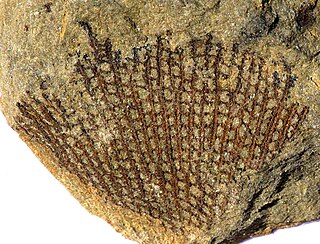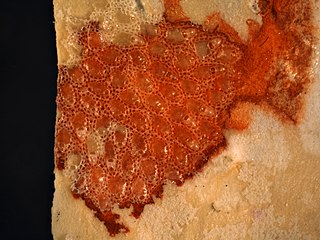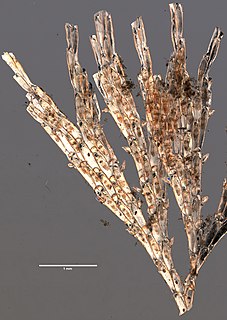
Bryozoa are a phylum of simple, aquatic invertebrate animals, nearly all living in sedentary colonies. Typically about 0.5 millimetres long, they have a special feeding structure called a lophophore, a "crown" of tentacles used for filter feeding. Most marine bryozoans live in tropical waters, but a few are found in oceanic trenches and polar waters. The bryozoans are classified as the marine bryozoans (Stenolaemata), freshwater bryozoans (Phylactolaemata), and mostly-marine bryozoans (Gymnolaemata), a few members of which prefer brackish water. 5,869 living species are known. One genus is solitary; all the rest are colonial.

Entoprocta, or Kamptozoa, is a phylum of mostly sessile aquatic animals, ranging from 0.1 to 7 millimetres long. Mature individuals are goblet-shaped, on relatively long stalks. They have a "crown" of solid tentacles whose cilia generate water currents that draw food particles towards the mouth, and both the mouth and anus lie inside the "crown". The superficially similar Bryozoa (Ectoprocta) have the anus outside a "crown" of hollow tentacles. Most families of entoprocts are colonial, and all but 2 of the 150 species are marine. A few solitary species can move slowly.

Cheilostomatida, also called Cheilostomata, is an order of Bryozoa in the class Gymnolaemata.

Membranipora membranacea is a very widely distributed species of marine bryozoan known from the Atlantic and Pacific Oceans, usually in temperate zone environments. This bryozoan is a colonial organism characterized by a thin, mat-like encrustation, white to gray in color. It may be known colloquially as the sea-mat or lacy crust bryozoan and is often abundantly found encrusting seaweeds, particularly kelps.

Cyclostomatida, or cyclostomata, are an ancient order of stenolaemate bryozoans which first appeared in the Lower Ordovician. It consists of 7+ suborders, 59+ families, 373+ genera, and 666+ species. The cyclostome bryozoans were dominant in the Mesozoic; since that era, they have decreased. Currently, cyclostomes seldom constitute more than 20% of the species recorded in regional bryozoan faunas.

A zooid or zoöid is a single animal that is part of a colonial animal. This lifestyle has been adopted by animals from separate unrelated taxa. Zooids are multicellular; their structure is similar to that of other solitary animals. The zooids can either be directly connected by tissue or share a common exoskeleton. The colonial organism as a whole is called a zoon, plural zoa.
The ascus is a diagnostic morphological feature of the bryozoan suborder Ascophora. It is a water-filled sac of frontal membrane opening (ascopore) at or near the zooid orifice. It functions as a hydrostatic system by allowing water into the space below the inflexible, calcified frontal wall when the zooid everts its polypide by muscles pulling the frontal membrane inwards. The ascus, along with a calcified frontal shield, define ascophoran bryozoa.
Perophora viridis, the honeysuckle tunicate, is a species of colonial sea squirt in the genus Perophora found in the tropical western Atlantic Ocean.
Amathia vidovici is a species of colonial bryozoans with a tree-like structure. It is found in shallow waters over a wide geographical range, being found in both the Atlantic and Pacific Oceans and adjoining seas.

Conopeum seurati is a species of colonial bryozoan in the order Cheilostomatida. It is native to the northeastern Atlantic Ocean, the North Sea and the Mediterranean Sea. This species has been introduced to New Zealand and Florida.

Fenestella is a genus of bryozoans or moss animals, forming fan–shaped colonies with a netted appearance. It is known from the Middle Ordovician to the early Upper Triassic (Carnian), reaching its largest diversity during the Carboniferous. Many hundreds of species have been described from marine sediments all over the world.

Electra pilosa is a species of colonial bryozoan in the order Cheilostomatida. It is native to the northeastern and northwestern Atlantic Ocean and is also present in Australia and New Zealand.

Cryptosula pallasiana is a species of colonial bryozoan in the order Cheilostomatida. It is native to the Atlantic Ocean where it occurs in northwestern Europe and northern Africa, and the eastern seaboard of North America. It has been accidentally introduced to the western coast of North America and to other parts of the world.

Beania magellanica is a species of colonial bryozoan in the family Beaniidae. It has a cosmopolitan distribution, occurring in shallow waters in the Atlantic and Pacific Oceans and in Antarctica.

Electra posidoniae is a species of bryozoan in the family Electridae. It is endemic to the Mediterranean Sea, and is commonly known as the Neptune-grass bryozoan because it is exclusively found growing on seagrasses, usually on Neptune grass, but occasionally on eelgrass.
Callopora lineata is a species of colonial bryozoan in the family Calloporidae. It is found on rocky shores in the Atlantic Ocean and the Mediterranean Sea.

Chorizopora brongniartii is a species of bryozoan in the family Chorizoporidae. It is an encrusting bryozoan, the colonies forming spreading patches. It has a widespread distribution in tropical and temperate seas.
Bicellariella ciliata is a species of bryozoan belonging to the family Bugulidae. It is found in shallow water on both sides of the Atlantic Ocean, the Mediterranean Sea and the Indo-Pacific region.
Crisularia plumosa is a species of bryozoan belonging to the family Bugulidae, commonly known as the feather bryozoan. It is native to the Atlantic Ocean.

Bugulina flabellata is a species of bryozoan belonging to the family Bugulidae. It is found in shallow water in the northeastern Atlantic Ocean and the Mediterranean Sea.













